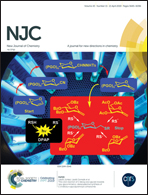The role of electron-attracting substituents and molecular stacking motifs in the charge transport of tetraazapyrene derivatives†
Abstract
The charge transport properties of a series of tetraazapyrene derivatives are theoretically investigated by means of quantum chemical calculations based on density functional theory. The effect of modifying the molecular structures on the charge transport properties is explained with quantitative Kohn–Sham molecular orbital analyses and corresponding energy decomposition analyses of the intermolecular interactions. The results reveal that the charge transfer does not depend on the substituent groups, such as the introduction of electron-attracting groups. Nevertheless, there is crucial evidence that the extension of the main chain and the increase in the number of heterocycles strengthen charge transfer in the systems. 3D visual diagrams of the anisotropy of the charge mobility in two different crystalline models of the same molecule are used to estimate the effect of molecular stacking motifs on the charge transfer properties. The maximum mobility is considered to be along the direction that is perpendicular to the molecular π–π stacking layers with the largest transfer integral values. In addition, spectral analyses of the polyheterocyclic derivatives provide novel conclusions about the effect of the molecular structures on the photophysical properties.



 Please wait while we load your content...
Please wait while we load your content...